
Chenopodium atrovirens is a species of flowering plant in the amaranth family known by the common names pinyon goosefoot and dark goosefoot.

Penstemon patens is a species of penstemon known by the common name Lone Pine beardtongue. It is native to the central Sierra Nevada of California and slopes and plateau to the east, its distribution extending just into Nevada. It grows in forest, woodland, and scrub habitat types. It is a perennial herb producing hairless, waxy stems up to about 40 centimeters tall. The thick, lance-shaped, gray-green, opposite leaves are up to 9 centimeters long and 2 wide. There are usually many leaves clustered around the base of the plant and smaller pairs higher on the stem. The inflorescence bears wide-mouthed tubular flowers up to 2 centimeters long with corollas in shades of lavender to magenta. The flower is mostly hairless except for the staminode which may have a coat of orange or yellowish hairs.
Penstemon scapoides is an uncommon species of penstemon known by the common name pinyon beardtongue. It is endemic to Inyo County, California, where it grows in the scrub, woodlands, and forests of the mountain ranges above the desert. It is a clumpy perennial herb forming a dense mat of oval to rounded leaves and erect flowering stems which may exceed half a meter in height. The leaves are pale green and coated densely in hairs. The inflorescence bears tubular flowers each up to 3.4 centimeters in length. The flowers are pale lavender to blue-purple and have yellowish hairs inside their mouths.

Carex specuicola is a rare species of sedge known by the common name Navajo sedge. It is native to a small section of the Colorado Plateau in the United States, its distribution straddling the border between Utah and Arizona, and completely within the Navajo Nation. There are several populations but they are limited to a specific type of habitat. The plants grow from the sides of steep, often vertical cliffs of red Navajo Sandstone, in areas where water trickles from the rock. It occurs at elevations between 5,700 and 6,000 feet, usually in shady spots. Though it is not a grass, the sedge grows in inconspicuous clumps resembling tufts of grass sticking out of the rock face. When the sedge was federally listed as a threatened species in 1985, it was known from only three populations in Coconino County, Arizona, with no more than 700 plants existing. The species has since been observed in northeastern Arizona and San Juan County, Utah.

Pediocactus despainii is a rare species of cactus known by the common names Despain's cactus and San Rafael cactus. It is endemic to the state of Utah in the United States, where it is limited to the San Rafael Swell in Emery County, Utah.
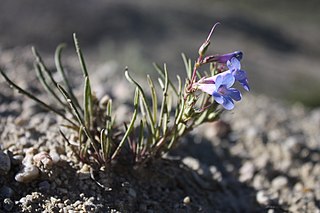
Penstemon penlandii is a rare species of flowering plant in the plantain family known by the common names Penland penstemon and Penland's beardtongue. It is endemic to Colorado in the United States, where it is known only from a strip of land about five miles long in central Grand County. There are two occurrences totalling about 8600 individuals. This is a federally listed endangered species of the United States.
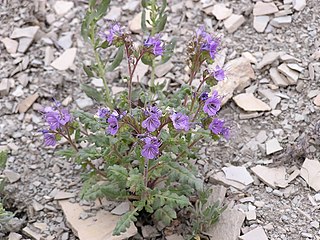
Phacelia argillacea is a rare species of flowering plant in the borage family known by the common names clay phacelia and Atwood's phacelia. It is endemic to Utah in the United States, where it is known only from one canyon in Utah County. It is "one of Utah's most endangered species"; it is "one of the nation's rarest plants" and is federally listed as an endangered species of the United States.

Pinguicula ionantha is a rare species of flowering plant in the butterwort family known by the common names Godfrey's butterwort and violet butterwort. It is endemic to the US state of Florida, where it only occurs in the central Florida Panhandle. It is threatened by the loss of its habitat, and it is a federally listed threatened species of the United States.

Glaucocarpum is a monotypic plant genus containing the single species Glaucocarpum suffrutescens, a rare species of flowering plant in the mustard family known by the common names Uinta Basin waxfruit, waxfruit mustard, toad-flax cress, and shrubby reed-mustard. It is endemic to Utah in the United States, where it is known only from Duchesne and Uintah Counties. It is threatened by habitat degradation and destruction. It is federally listed as an endangered species of the United States.
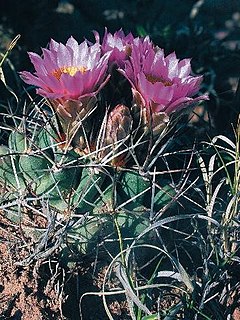
Sclerocactus glaucus is a rare species of cactus known by the common name Colorado hookless cactus. It is endemic to Colorado in the United States, where it is known only from the area between Grand Junction and Montrose. It is a federally listed threatened species.
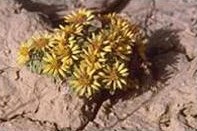
Townsendia aprica is a rare species of flowering plant in the aster family known by the common name Last Chance Townsend daisy. It is endemic to Utah in the United States, where it is known from three counties. It faces a number of threats and it is a federally listed threatened species of the United States.
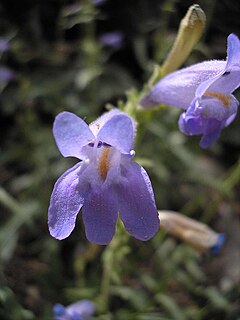
Penstemon pudicus is a rare species of flowering plant in the plantain family known by the common names bashful beardtongue and Kawich Range beardtongue. It is endemic to Nevada in the United States, where it is known only from the Kawich Range in Nye County.

Penstemon rhizomatosus is a rare species of flowering plant in the plantain family known by the common names Scheel Creek beardtongue and rhizome beardtongue. It is endemic to Nevada in the United States, where it occurs only in the Schell Creek Range of White Pine County.

Penstemon degeneri is a species of flowering plant in the plantain family known by the common name Degener's beardtongue. It is endemic to Colorado in the United States, where it occurs in and around the Arkansas River Canyon in Fremont, Custer, and Chaffee Counties.
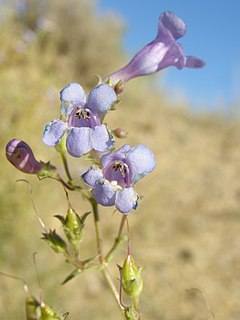
Penstemon gibbensii is a species of flowering plant in the plantain family known by the common name Gibbens' beardtongue. It is native to the western United States, where it occurs in Wyoming, Colorado, and Utah.
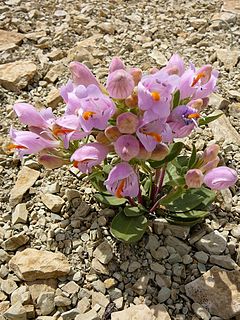
Penstemon grahamii, known by the common names Uinta Basin beardtongue and Graham's beardtongue, is a species of flowering plant in the plantain family. It is native to Utah and Colorado in the United States.

Penstemon acuminatus is a species of flowering plant in the plantain family known by the common names sharpleaf penstemon and sand-dune penstemon. It is native to the northwestern United States, where it occurs in Washington, Oregon, Idaho, Utah, and Nevada.

Eriogonum soredium is a species of wild buckwheat known by the common name Frisco buckwheat. It is endemic to Utah in the United States, where it is known only from Beaver County. There are four populations, all located in the San Francisco Mountains. It is a candidate for federal protection.

Penstemon eriantherus is a species of flowering plant in the plantain family known by the common names fuzzytongue penstemon and crested beardtongue. It is native to western North America, where it occurs in western Canada and the northwestern and north-central United States.
Penstemon franklinii, or Franklin's penstemon, is a plant species endemic to Utah, United States, known only from Cedar Valley in Iron County. It grows in grasslands and in sagebrush communities.



















